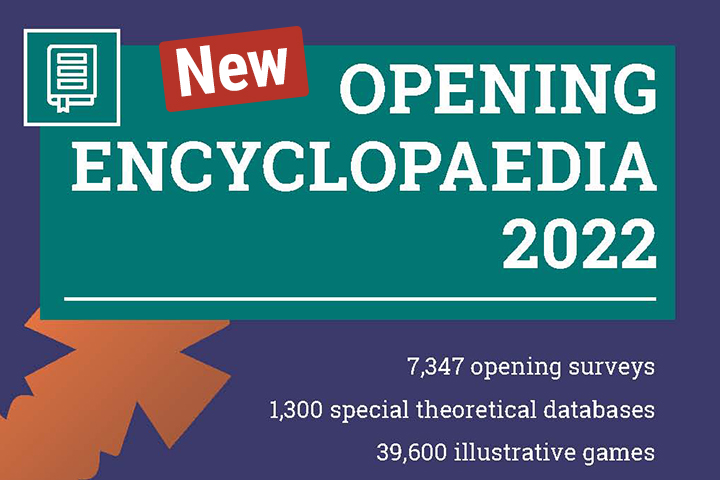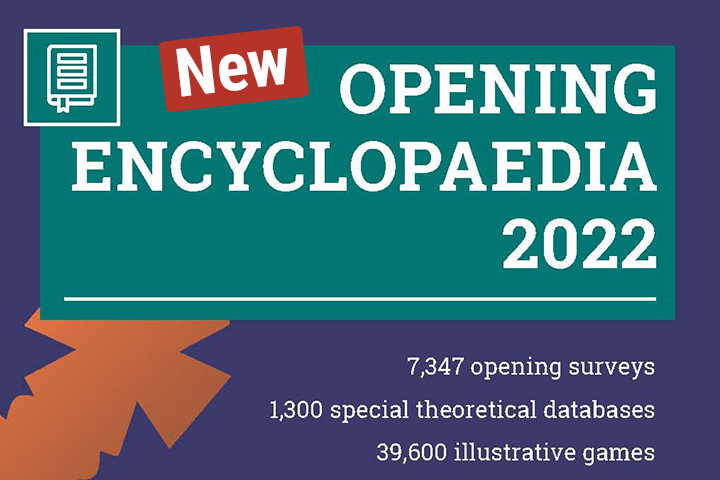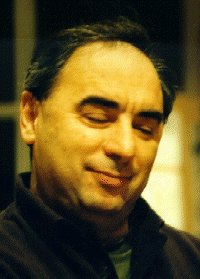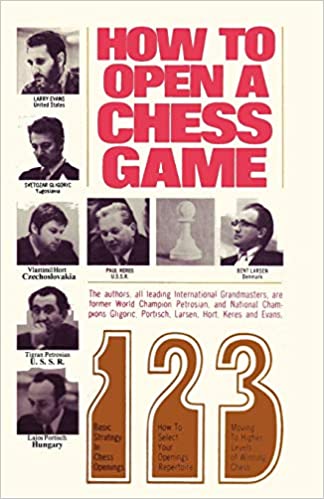


 Opening theory in chess has come a long way. First, we have had MCO followed by ECO, NCO and FCO. Then we have had the New in Chess Yearbook and it has only recently bid adieu to the disappointment of its fans. Currently only ChessPublishing.com and ChessBase Magazine are still leading from the front in opening theory. Each issue of the ChessBase Magazine has a minimum of 10 theoretical surveys. I always wondered how I could check out the whole series of these articles at one go. In a way this Encyclopaedia solves the problem.
Opening theory in chess has come a long way. First, we have had MCO followed by ECO, NCO and FCO. Then we have had the New in Chess Yearbook and it has only recently bid adieu to the disappointment of its fans. Currently only ChessPublishing.com and ChessBase Magazine are still leading from the front in opening theory. Each issue of the ChessBase Magazine has a minimum of 10 theoretical surveys. I always wondered how I could check out the whole series of these articles at one go. In a way this Encyclopaedia solves the problem.
But this work is more than a compilation of writings on opening variations. It also has opening videos, tutorials, databases and games, annotated and unannotated. For who is it intended? I would say, for everyone who wants to learn.
Here I shall deal with the treatment of open games starting with 1.e4 e5.
If you are a talented young player or a club level player, first see lines with direct piece play. You pick up some good tactics on the way. Now why this advice? If you look at grandmaster practice, it’s full of positional lines with a slow buildup. Lines starting with 1.e4 e5 2.Nf3 Nc6 3.Bc4 Nf6 or 3.Bg5 Nf6 often continue with 4.d3. Here the Ruy Lopez and Giuoco Piano meet. It’s a trend set by Carlsen and his peers over the years.
But you are not Magnus and you don’t have to play these lines unless you are instinctively inclined to play positions that involve slow manoeuvring. If you are a king pawn player, learn the Spanish. As Kasparov once pointed out, understanding the Spanish is an education in itself, even if you are not going to play every single line in your life. Among the Main Systems you have the Keres, Smyslov, Breyer and Zaitsev Variations.
Keres in particular took a lot of trouble to preserve his system, especially because he had Fischer and Tal playing White against him during Candidates’ Tournament, Curacao 1962. With Tal the score was 2-0 and with Fischer it was 1-1.

But the argument between the two did not end there. Bobby annotated his victory over Keres in his classic work My 60 Memorable Games. He wrote, “Keres’ novelty introduced on this occasion has since become fashionable. I was and still am unimpressed. Black loses time redeveloping his knight to QN3, but the kingside is weakened by its absence and it’s questionable whether the knight is not better where it stands originally.”
Indeed, Black loses a tempo retreating the knight to the second rank. As a result, he also loses the pressure on d5 that he exerted with the knight on f6. A side effect of this move is that the queen’s bishop can no longer be deployed on the c8-h3 diagonal.
Keres understood it all and offered a detailed response to this argument in his essay The secret workshop of a grandmaster, annotating all four games with Fischer and Tal
This “debate” between two great chess minds on the Spanish is a revelation. Fischer’s criticism of the absence of the knight on the kingside and the time spent on moving to …b6 did not go unnoticed. It was Alexander Graf who demonstrated that the knight could move to the powerful square e5 if it could be vacated on 12.Nbd2 exd4 (rather than the usual 12...cxd4).
Martin Breutigam analyses it all here in a survey in this Encyclopedia.
But it’s ten years old! In itself this should not be a cause for worry as there have been fewer games in this decade changing the evaluation of the Keres System. I still think the following line is not easy to play:
Select an entry from the list to switch between games
The dilemma for Black in this line is whether he should seek counter play on the queenside with …a6-a5 or prepare …f7-f5 on the kingside. If he does nothing, he will be smothered as White has space advantage with 12.d5.
The main line in the Graf Variation offers more resources for Black. Here is a critical encounter:
While Black lost this game, he could have turned tables on White in the later middlegame.
Here I have dealt with jut one of the Black systems against the Spanish. One could write a whole treatise on each of the others.
Note that older systems like the Chigorin Main Line, Smyslov and Breyer Variations do not have recent updates in this Encyclopaedia. They have been extensively played and analysed for decades. So they are not in vogue in grandmaster practice. However, this state of affairs could change any time.
If you are on the Black side of the Spanish in the Main Variation, you will have to be ready with side lines at every turn till you get a chance to play your favourite system occurring on the 9th move or so. So be prepared.
 One section that needs to be updated is the work on the King’s Gambit.
One section that needs to be updated is the work on the King’s Gambit.
During the 1990s Alexander Bangiev (pictured) did some valuable work on this opening and it’s included here. However, thereafter ChessBase itself has produced a string of DVDs on the King’s Gambit. The most recent is Power Play 27 and 28 - The King's Gambit and Tactic Toolbox from August 2020.
The main analysis in this DVD set is yet to be included in the Encyclopaedia here. Meanwhile readers can help themselves with John Shaw’s seminal work on this opening
How should players with Black deal with the King’s Gambit? They can accept the gambit pawn and be prepared for a tactical slug fest. If not, they can go for the Falkbeer Counter Gambit. Here is the position in the Old Main Line: 1.e4 e5 2.f4 d5 3.exd5 e4
Dr. Tarrasch wrote: “It’s directed against the White position that is already compromised by the move 2.f4. It completely invalidates White’s intentions. The f-file is not opened. On the contrary the f-pawn is isolated, to speak. The occupation of the centre is already impossible”.
Subsequently an antidote to the Falkbeer Main Line was found with 4.d3! and it has been analysed in detail and there are few surprises in it any more. The challenge lies in the Falkbeer-Nimzowitsch Counter Gambit. In this Encyclopaedia, we have a glimpse of the same in Survey No. 6898 authored by Alexander Bangiev. No complete games, though. Here I shall offer a short line that shows the dangers for White if he accepts the counter gambit.

Aron Nimzowitsch | Photo: Unknown via Per Skjoldager, Lund Chess Academy
It’s a rare coincidence that both Tarrasch and Nimzowitsch, arch rivals otherwise, contributed in different ways to the Falkbeer Counter Gambit.
Is the King’s Gambit playable in 2022? Now that question should be addressed to Ian Nepomniachtchi and Ding Liren. Ian has had a measure of success with White. He has beaten Viswanathan Anand and Alireza Firouzja among others.
But then he has also lost to Levon Aronian and Ding Liren. The latter has beaten both Magnus and Ian with Black pieces.
In this context let me mention a rare bird in King’s Gambit, the Schallop Defence. It figured in both Nepomniachtchi-Firouzja and Carlsen-Ding Liren encounters. Nepo won and Magnus lost. In each case it was the better opening preparation. Aficionados of King’s Gambit should check out Krisztian Szabo’s analysis of the Schallop Defence in this Encyclopaedia. He is critical of time-honoured lines and makes no allowances for weak play in the opening.
So what can one say about the King’s Gambit? There is nothing like it for sheer romance and adventure in chess. It is also a surprise weapon in rapid and blitz tournaments. However, you have to be thorough in your preparation.
 This brings me to the general question: How should one go about learning opening theory? Have databases aided by engines replaced books altogether? Not really. Today books and computers complement each other. So learn from both. There is no lack of books on the open games. I have offered a short list below this review. It’s also interesting to see how opening theory has evolved.
This brings me to the general question: How should one go about learning opening theory? Have databases aided by engines replaced books altogether? Not really. Today books and computers complement each other. So learn from both. There is no lack of books on the open games. I have offered a short list below this review. It’s also interesting to see how opening theory has evolved.
In this context I shall mention an old classic, How to Open a Chess Game (RHM Press 1974). In this book each grandmaster draws from his own life experience and explains how to play an opening. One should read such books not to copy or follow a particular player, but to draw inspiration from each of them and develop a repertoire according to one’s own temperament and style.
Whenever you are interested in a particular opening in this Encyclopaedia, ask yourself two questions:
I have one issue with the screen view. Currently it shows both the text of an opening variation and the rest of the Encyclopaedia contents with hyperlinks. I would prefer to have a complete screen view of the opening line under scrutiny. It’s more reader-friendly.
In the next part of the series on this Encyclopaedia I shall deal with Semi-Open Games.
| Advertising |